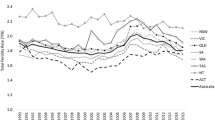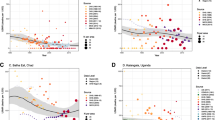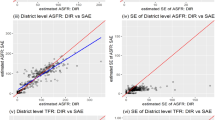Abstract
Many agencies require population estimates and projections by ethnic group. These projections need ethnic-specific, age-specific fertility rates (ASFRs) but their inclusion is challenging since ethnicity is not recorded at birth registration. In this paper maternity data are used in a case study of electoral wards in Bradford, West Yorkshire, to develop fertility rates for small populations for a 1991 based projection. The challenge is to capture local variations in fertility by ethnic group when data are sparse. Small areas were grouped together using cluster analysis to define combinations with similar sociodemographic and fertility experiences so that sparse data could be aggregated to estimate reliable ethnic-specific fertility rates. For comparison, the data were aggregated into the 1991 Office for National Statistics area type classification. Fertility rates by single year of age for all area types were smoothed using the Hadwiger function. For the White ethnic group there were sufficient births to create ethnic-specific, ward-level ASFRs. For other ethnicities grouping of areas was necessary. The accuracy of the ASFRs in predicting births was assessed using mean absolute percentage error. Results show that for some minority groups district-level ethnic-specific fertility rates produced the most accurate birth estimates even though they were based on a larger area. This implies that rates created may be informative about the local area for White ethnic type but not in the same way for smaller ethnic groups. In terms of grouping strategies we recommend that existing classifications are assessed to determine how well variations in rates are stratified before embarking on a custom scheme. Where population sub-groups are small in some areas, it may be more reliable to use rates derived for larger areas and apply these to local populations. Inevitably, the rates used in a projection are a compromise but hopefully will still capture important dimensions of population change.






Similar content being viewed by others
References
Ahmad, W. (1999). Ethnic statistics: Better than nothing or worse than nothing. In D. Dorling & S. Simpson (Eds.), Statistics in society: The arithmetic of politics. London: Arnold.
Aspinall, P. J. (1995). Department of Health’s requirement for mandatory collection of data on ethnic group of inpatients. British Medical Journal, 311(7011), 1006–1009.
Aspinall, P. J. (2001). Operationalising the concept of ethnicity data in studies of sociology of health and illness. Journal of Health and Illness, 23(6), 829–862.
Bains, B., & Klodawski, E. (2004). Ethnic group fertility rates for London using HES. Paper presented to BSPS Conference, Leicester, 14 September.
Bongaarts, J. (1978). A framework for analyzing the proximate determinants of fertility. Population and Development Review, 4(1), 105–132.
Boyle, P. J. (2003). Population geography: Does geography matter in fertility research? Progress in Human Geography, 27(5), 615–626.
Brass, W. (1960). The graduation of fertility distributions by polynomial functions. Population Studies, 14, 148–162.
Chandola, T., Coleman, D. A., & Hirons, R. W. (1999). Recent European fertility patterns: Fitting curves to ‘distorted’ distributions. Population Studies, 54(3), 317–329.
Chandola, T., Coleman, D. A., & Hirons, R. W. (2002). Distinctive features of age-specific fertility profiles in the English-speaking world: Common patterns in Australia, Canada, New Zealand and the United States, 1970–98. Population Studies, 56(2), 181–200.
Coleman, D. (2010). Projections of the ethnic minority populations of the United Kingdom 2006–2056. Population and Development Review, 36(2), 441–486.
Coleman, D. A., & Dubuc, S. (2010). The fertility of ethnic minorities in the UK, 1960s–2006. Population Studies, 64(1), 19–41.
Coleman, D., & Salt, J. (1996). The ethnic group question in the 1991 Census: A new landmark in British social statistics. In D. Coleman & J. Salt (Eds.), Ethnicity in the 1991 Census of Population (1) Demographic characteristics of the ethnic minority populations (pp. 1–27). London: ONS, HMSO.
Congdon, P. (1990). Graduation of fertility schedules: An analysis of fertility patterns in London in the 1980s and an application to fertility forecasts. Regional Studies, 24(2), 311–326.
Congdon, P. (1993). Statistical graduation in local demographic-analysis and projection. Journal of the Royal Statistical Society Series A, 156(2), 237–270.
Dennett, A., & Stillwell, J. (2010). Internal migration in Britain, 2000–01, examined through an area classification framework. Population Space and Place, 16(6), 517–538.
Dubuc, S. (2009). Application of the Own-Children Method for estimating fertility by ethnic and religious groups in the UK. Journal of Population Research, 26, 207–225.
Gilje, E. (1969). Fitting curves to age-specific fertility rates: Some examples. Statistisk tidskrift (Statistical Review of the Swedish National Central Bureau of Statistics), Series, 3(7), 118–134.
Haskey, J. (2000). Projections of the population by ethnic group: A sufficiently interesting or a definitely necessary exercise to undertake? Population Trends, 102, 34–40.
Haskey, J. (2002). Population projections by ethnic group: A feasibility study. SMPS No. 67. HMSO.
Hay, G., & Hollis, J. (2005) Borough fertility rates: 2000–02. Data Management and Analysis Group DMAG Briefing 2005/9: Greater London Authority.
Hinde, A. (1998). Demographic methods. London: Arnold Publishers.
Hoem, B. (2000). Entry into motherhood in Sweden: The influence of economic factors on the rise and fall in fertility, 1986–1997. Demographic Research, 2(4): doi:10.4054/DemRes.2000.2.4.
Hoem, J. M., & Berge, E. (1975). Some problems in the Hadwiger Fertility Graduation. Scandinavian Actuarial Journal, 58, 129–144.
Hoem, J. M., & Holmbeck, B. (1975). The demographic interpretation of the basic parameters in Hadwiger Fertility Graduation. Statistical Review of the Swedish National Central Bureau of Statistics, Series, 3(13), 369–375.
Hoem, J. M., Madsen, D., Nielsen, J. L., Ohlsen, E.-M., Hansen, H. O., & Rennermaln, B. (1981). Experiments in modelling recent danish fertility curves. Demography, 18, 231–244.
Klodawski, E. (2003). Fertility of ethnic groups in London. London: Greater London Authority.
Large, P., & Ghosh, K. (2006). Population estimates by ethnic group–Methodology paper. January 2006. www.statistics.gov.uk/downloads/theme_population/MethodologyforPEEG.pdf. Accessed 28 January 2006.
McNeil, D. R., Trussell, J. T., & Turner, J. C. (1977). Spline interpolation of demographic data. Demography, 14(2), 245–252.
Nanjo, Z. (1986). Practical use of interpolatory cubic and rational spline functions for fertility data (Vol. 34, pp. vi–13). NUPRI Research Paper Series. Tokyo: Nihon University.
Ní Bhrolcháin, M. (1990). The ethnicity question for the 1991 Census: Background and issues. Ethnic and Racial Studies, 13, 542–567.
Norman, P. (2011). Relationships between UK subnational trends in infant mortality and fertility. In J. Stillwell & M. Clarke (Eds.), Population dynamics and projection methods, understanding population trends and processes (Vol. 4, pp. 99–114). Dordrecht: Springer.
Norman, P., & Bambra, C. (2007). Unemployment or incapacity? The utility of medically certified sickness absence data as an updatable indicator of population health. Population, Space & Place, 13(5), 333–352.
Norman, P., Rees, P., Wohland, P., & Boden, P. (2010). Ethnic group populations: The components for projection, demographic rates and trends. In J. Stillwell & M. van Ham (Eds.), Ethnicity and integration, understanding population trends and processes (Vol. 3, pp. 289–315). Berlin: Springer.
Norman, P., Simpson, L., & Sabater, A. (2008). ‘Estimating with confidence’ and hindsight: New UK small area population estimates for 1991. Population, Space and Place, 14(5), 449–472.
Office for National Statistics (ONS) (1999). Subnational population projections. PP3, No10. TSO, London.
Office for National Statistics (ONS) (2003). Ethnic group statistics: A guide for the collection and classification of ethnicity data. HMSO. www.statistics.gov.uk/about/ethnic_group_statistics/downloads/ethnic_group_statistics.pdf. Accessed 6 December 2005.
Office for National Statistics (ONS)/GROS. (1997) ONS 6-fold classification of wards. Available in conjunction with the 1991 Area Master File: http://census.ac.uk/cdu/Datasets/Lookup_tables/Area_Master_File.htm.
POPGROUP. (2010). Small area forecasts. www.ccsr.ac.uk/popgroup/SmallAreas.htm. Accessed 28 November 2010.
Rees, P. (1994). Estimating and projecting the populations of urban communities. Environment and Planning A, 26, 1671–1697.
Rees, P., Norman, P., & Brown, D. (2004). A framework for progressively improving small area population estimates. Journal of the RSS Series A, 167(1), 5–36.
Rees, P., Wohland, P., & Norman, P. (2009). The estimation of mortality for ethnic groups at local scale within the United Kingdom. Social Science and Medicine, 69, 1592–1607.
Rindfuss, R. R. (1991). The young adult years: Diversity, structural change, and fertility. Demography, 28(4), 493–512.
Rogers, A., & Raymer, J. (1999). Estimating the regional migration patterns of the foreign-born populations in the United States: 1950–1990. Mathematical Population Studies, 7(3), 181–216.
Rowland, D. T. (2003). Demographic methods and concepts. Oxford: Oxford University Press.
Schmertmann, C. (2003). A system of model fertility schedules with graphically intuitive parameters. Demographic Research, 9(5), 1–32.
Senior, M. L. (2002). Deprivation indicators. In P. Rees, D. Martin, & P. Williamson (Eds.), The census data system (pp. 123–137). Chichester: John Wiley.
Sharma, S. (1996). Applied Multivariate Techniques. USA: John Wiley and Sons Inc.
Simpson, L. (2000). Population change in Bradford District: Age, sex and ethnic group. City of Bradford MDC report, Policy and Research Unit.
Simpson, L. (2002). Estimation methodologies and assumptions for projections: Current practice for population projections by ethnic group. In Haskey J. (Ed.), Population projections by ethnic group a feasibility study (pp. 53–72). London: HMSO. No. 67.
Simpson, S. (1997). Demography and ethnicity: Case studies from Bradford. New Community, 23(1), 89–107.
Simpson, S. (1998). Making local population statistics: A guide for practitioners (from the Estimating with Confidence project). Wokingham: LARIA.
Simpson, S., Middleton, L., Diamond, I., & Lunn, D. (1997). Small-area population estimates: A review of methods used in Britain in the 1990 s. International Journal of Population Geography, 3, 265–280.
Smith, S. K., & Tayman, J. (2003). An evaluation of population projection by age. Demography, 40(4), 741–757.
Smith, S. K., Tayman, J., & Swanson, D. A. (2001). State and local population projections methodology and analysis. New York: Kluwer Academic/Plenum Publishers.
Sporton, D., & White, P. (2002). Fertility. In Haskey J. (Ed.), Population projections by ethnic group a feasibility study (pp. 81–92). London: HMSO. No. 67.
Stillwell, J., Hussain, S., & Norman, P. (2008). The internal migration propensities and net migration patterns of ethnic groups in Britain. Migration Letters, 5(2), 135–150.
Storkey, M. (2002a). A review of literature on ethnic group projections. In Haskey, J. (ed.) Population projections by ethnic group a feasibility study. HMSO. No. 67, 1–16.
Storkey, M. E. (2002b). Population projections of different ethnic groups in London 1991 to 2011, unpublished Ph.D thesis, Department of Social Statistics, Faculty of Social Sciences, University of Southampton, January 2002.
Wallace, M., & Denham, C. (1996). A socio-economic classification of local and health authorities of Great Britain. SMPS No 59. London: HMSO.
Williamson, L. (2003). Population projections of minority ethnic groups in England: What can we conclude from the differences with the 2001 Census? Paper presented at BSPS Conference, Bristol, September.
Williamson, L. E. (2006a). Developing strategies for deriving small population mortality rates. CCSR Working Paper 2006–10. Manchester: The University of Manchester.
Williamson, L. E. (2006b). Developing strategies for deriving small population migration rates. CCSR Working Paper 2006–11. Manchester: The University of Manchester.
Williamson, L. E. P. (2007). Population projections for small areas and ethnic groups–developing strategies for the estimation of demographic rates, unpublished Ph.D thesis, School of Social Science, Faculty of Humanities, University of Manchester.
Wohland,P., Rees, P., Norman, P., Boden, P., & Jasinska, M. (2010). Ethnic population projections for the UK and local areas, 2001–2051. Working Paper 10/2, School of Geography, University of Leeds.
Yntema, L. (1969). On Hadwiger’s fertility function. Statistisk tidskrift (Statistical Review of the Swedish National Central Bureau of Statistics), Series, 3(7), 113–117.
Acknowledgments
This work is based on Lee Williamson’s Ph.D thesis (Williamson 2007), a CASE studentship (S42200124001) funded by ESRC and Bradford Metropolitan District Council. Paul Norman’s research is funded by ESRC grants RES-163-25-0032 and RES-189-25-0162. The authors would like to thank Bradford Metropolitan District Council for allowing access to the Bradford Birth Statistics Database and the forecasting software ‘POPGROUP’ that enabled this research. 1991 Census data were obtained through the MIMAS CASWEB facility and the GIS boundary data through EDINA’s UKBORDERS facility, academic services supported by ESRC and JISC. The Census, official Mid-Year Estimates and Vital Statistics have been provided by ONS and the digital boundary data by OSGB. These data are Crown copyright and are reproduced with permission of the Office of Public Sector Information. The authors are very grateful to two anonymous referees whose useful comments helped to improve this work.
Author information
Authors and Affiliations
Corresponding author
Rights and permissions
About this article
Cite this article
Williamson, L., Norman, P. Developing strategies for deriving small population fertility rates. J Pop Research 28, 129–148 (2011). https://doi.org/10.1007/s12546-011-9059-0
Published:
Issue Date:
DOI: https://doi.org/10.1007/s12546-011-9059-0




